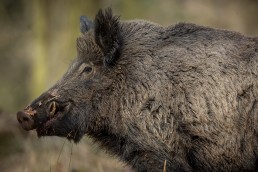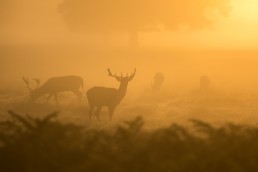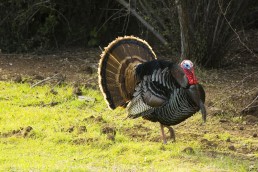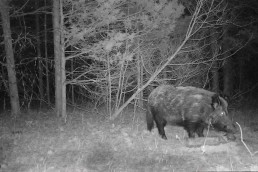MoNews
SHARE THIS POST
MDC continues work to remove feral hogs from the landscape
Missouri Department of Conservation (MDC) wildlife biologists on the feral hog strike team worked with partner agencies and private landowners to remove 5,358 feral hogs from Missouri’s landscape, a significant increase over 2015 when 3,649 feral hogs were removed.
Some contributing factors to the increase include MDC’s “Report, don’t shoot” message to encourage trapping, the banning of hog hunting on conservation areas and a strong public awareness campaign.
Southeast Missouri trapped 2,941 feral hogs, as it reportedly has the highest density of hogs. The Ozark region trapped 1,293 while the Southwest region trapped 1,006 hogs. St. Louis, Central and Kansas City regions all trapped fewer than 100 feral hogs each.
Alan Leary, MDC’s Wildlife Management Coordinator and leader of the Department’s feral hog eradication efforts said the goal is to eradicate feral hogs in the state, but a more immediate goal is to keep the feral hog population from spreading to those northern regions.
“We made significant progress in 2016,” Leary said. “The key to eradicating these destructive, invasive pests is cooperation with private landowners and partners in efforts to report hog sightings, continue trapping, and deter hog hunting and the illegal release of hogs.”
In 2016, MDC collaborated with other conservation groups, agriculture organizations and the Missouri Conservation Heritage Foundation to provide the state’s feral hog strike team with more trapping equipment for use on both private and public land. This was also done to fund public education efforts on the dangers of feral hogs. MDC increased communication efforts, bolstering an already active feral hog communications campaign with statewide media efforts on agricultural news stations. Through this campaign, the public heard from private landowners who suffered hog damage and are working with MDC and USDA to eradicate feral hogs. They also helped spread the message to “Report, don’t shoot” these animals.
“The majority of land in Missouri is privately owned, so it’s crucial that we engage the public, educate them on the dangers of feral hogs and engage them in our trapping efforts,” Leary said. “Through our communications campaign, more landowners are learning more about feral hogs and asking for help and ridding their property of this invasive species.”
Landowners are also learning that it is easier to get rid of feral hogs if you trap the whole sounder (group), rather than allow hunting and only shooting one or two, he said.
While hunting is a very effective tool for managing populations of wildlife, feral hogs are not wildlife and the goal is to remove them. Killing feral hogs for sport hinders efforts to eradicate them for several reasons.
“Some hunters intentionally release feral hogs in new areas to establish populations to hunt, and hunters usually only shoot one or two hogs out of the group while the rest scatter across the landscape and become more difficult to catch,” Leary said. “Hunting actually compounds the problem.”
While trapping is an effective method for eradicating these hogs, when it comes to the remaining few of a group, they are difficult to eliminate. Feral hogs are great at noticing details that “tip them off” to avoid a trapping area. They have coloring that blends into the landscape and hide in thickets and dense cover. In the winter when trees are bare the MDC occasionally uses aerial gunning to reach the ultimate goal of removing this elusive, invasive animal from the landscape.
Through the combination of these techniques, MDC’s feral hog team has made progress eradicating the feral hogs.
“It’s vital we continue our efforts and get the feral hog population under control before it spreads,” Leary said.
Economic losses resulting from feral hog damage in the U.S. is estimated at greater than $1.5 billion per year. They damage property, agriculture and natural resources by their aggressive rooting of soil in addition to their trampling and consumption of crops as part of their daily search for food.
Their range has expanded in the U.S. from 17 to 38 states over the past 30 years. Populations grow rapidly because they can breed any time of year and produce two litters of one to seven piglets every 12 to 15 months. Feral hogs can carry diseases such as swine brucellosis, pseudorabies, trichinosis and leptospirosis, which are a threat to Missouri agriculture and human health.
To report feral hog sightings or damage, go online to mdc.mo.gov/feralhog.
Two more farms participate in NBCI program
The National Bobwhite Conservation Initiative (NBCI) moved a step closer to two of its major goals for landscape restoration of wild bobwhites, reconnecting cattle and quail and reconnecting forests and quail.
The Natural Resources Conservation Service (NRCS) announced the recent approval of two NBCI-led proposals to recognize bobwhites in the NRCS Working Lands for Wildlife program.
“We were really pumped to receive two bobwhite proposals,” NRCS Chief Jason Weller said, on the approval of the projects. “These projects represent what’s best for America-family ownership, conservation, helping communities and partnerships.”
With a goal of affecting 232,000 targeted acres in 13 states by fiscal year 2018, this WLFW accomplishment may be the largest concentrated effort ever applied to reintegrating wild bobwhites into this nation’s working landscapes, said Don McKenzie, NBCI director.
The grasslands proposal targets 150,000 acres in eight states: Arkansas, Illinois, Indiana, Kentucky, Missouri, North Carolina, Ohio and Virginia. The plan will provide technical and financial assistance to landowners interested in converting pastures of exotic, endophyte-infected fescue to drought-tolerant native grasses and wildflowers, along with developing prescribed grazing plans.
Are you enjoying this post?
You can be among the first to get the latest info on where to go, what to use and how to use it!
“It is estimated that as much as 85 percent of tall fescue is infected with an endophyte fungus that causes cattle a wide range of problems,” McKenzie says. “And as a cool-season grass, fescue doesn’t produce nearly as well as natives during the droughty summer months. A strategic landscape-scale mixture of native warm-season grasses and forbs that complement prevalent, introduced cool-season forages will help producers, cattle, quail and other grasslands wildlife.”
The forestlands proposal targets 82,000 acres across six states including Alabama, Florida, Georgia, New Jersey, North Carolina and South Carolina, and will provide technical and financial assistance to landowners interested in restoring declining pine savanna habitat using native grasses, timber thinning and prescribed fire. Pine savanna is a diverse ecosystem supporting bobwhites and more than 300 other species.
“These projects, which are targeted for maximum impact, were coordinated by NBCI and approved by the NRCS State Conservationists in each participating state,” McKenzie said. “Numerous close partners played key roles, including the UT Center for Native Grasslands Management, the Central Hardwoods Joint Venture, the Georgia Department of Natural Resources, NRCS state and regional offices, various state wildlife agency quail coordinators and the National Bobwhite Technical Committee’s grasslands/grazing lands, agriculture and forestry subcommittees.”
New Madrid County R-1 Middle School is 600th in the MoNASP
The Missouri Department of Conservation (MDC) announced New Madrid County R-1 Middle School is the 600th school to participate in the Missouri National Archery in the Schools Program (MoNASP). MDC officials presented the school with a check for $1,500 and the Missouri Conservation Heritage Foundation (MCHF) presented the school with a $1,700 check, to cover costs of equipment for the program at the ceremony
“We are thrilled to be recognized as the 600th Missouri school to participate,” said Dr. Sam Duncan, New Madrid R-1 superintendent. “Our students and their parents are even more excited than the school personnel because it made them feel that they were a part of something really special.”
MoNASP is part of the total National Archery in the Schools Program (NASP). Eric Edwards, MDC MoNASP coordinator, said having 600 schools participating in the program puts Missouri as one of the top 10 states involved in NASP.
“MoNASP is proven to affect students’ attitudes about school, improve behavior and give the students a sense of belonging,” Edwards said. “Schools that conduct MoNASP contact me regularly to report a real positive change in their students after incorporating archery into their school curriculum.”
The program teaches more than archery shooting techniques. It teaches students to slow down and concentrate on the process, as they must work on 11 prescribed steps to archery success.
“This ability they find in archery to concentrate and link the steps together carries over into the classroom and their school work,” Edwards said. “They must self-analyze what was good and what could have been better with each individual shot, which translates into their school work in that they must self-evaluate how they did on homework, quizzes, and tests and decide what they could have done differently to provide a better result.”
More than 650,000 students in Missouri have participated in MoNASP since it started in 2007. MoNASP is a program for grades fourth through twelfth. Edwards said students involved get excited about going to school and want to be there because of the program. It helps students learn to work together and lets many students who are otherwise not involved in any other physical activity be part of a group. Many schools start archery clubs either before or after school to fit in extra practice in order to compete at a higher level at one of over 100 MoNASP tournaments. More than 2,400 archers will compete in the program-sponsored State Tournament this spring in Branson.
Edwards said the truly special aspect of MoNASP is that any school and any student can participate.
“We have schools that have 30 students in the entire building do this program and schools that have well over 1,000 students participating,” Edwards said. “MoNASP can fit any school.”
MDC and the Conservation Federation of Missouri offer reimbursement grants to help schools purchase equipment. MDC provides NASP certification to any Missouri schoolteacher free of charge. See more information about MoNASP at http://on.mo.gov/2lcxYUU.
Healthy Watershed plan completed for the Lower Grand River Watershed
The Green Hills Regional Planning Commission, in partnership with the Missouri Department of Natural Resources, hosted five Healthy Watershed Meetings for the Lower Grand River Watershed.
The Lower Grand River Watershed is located in north-central Missouri and drains 2,360 square miles (about 1.5 million acres) of portions of eight counties, including Putnam, Sullivan, Mercer, Grundy, Linn, Livingston, Carroll and Chariton counties. Major tributaries within this watershed include Medicine, Locust, Yellow, Elk, Turkey, Muddy, Parson, Big and Salt creeks. The Grand River meets the Missouri River at Brunswick, at the most downstream portion of this watershed.
All five of the meetings were held at the MU Forage Systems Research Center near Linneus. Several hundred potential stakeholders were invited to participate in the meetings and approximately 71 stakeholders attended at least one of the meetings.
Each meeting included a series of presentations that provided information about the watershed or aspects of watershed science. During the latter half of each meeting, participants brainstormed and discussed recommended actions for identified issues and priorities in the watershed. Their ideas formed the basis of the Healthy Watershed Plan.
The completed plan is available on the Green Hills Regional Planning Commission’s website at ghrpc.org/index.htm, along with the presentations from each of the meetings. The Healthy Watershed Plan is intended to be a living document that provides guidance and recommendations from local stakeholders to help address issues in the watershed.
More information about the Lower Grand River Watershed can be found at dnr.mo.gov/omw/
MWO
SHARE THIS POST
You may also like...
Did you enjoy this post?
You can be among the first to get the latest info on where to go, what to use and how to use it!
Darrell Taylor
Darrell Taylor has fished for more than 65 years. During the past 25 years, Taylor has generated more than 2,000 published articles, columns and fishing reports. His writings received 14 peer-level awards from outdoor writer organizations, including the Association of Great Lakes Outdoor Writers “Excellence in Craft” Golden Glow Award, their highest recognition.



